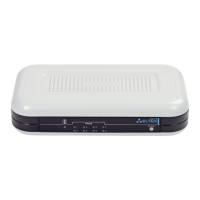____________________________________________________________________________________
____________________________________________________________________________________
70 VoIP subscriber gateways
– Group call pickup enable – when checked, incoming call of the serial group may be picked up by
other subscribers from the same pickup group (with the same SIP profile);
– Ports – to add port into serial group, click the preferred port in the ‘Available’ list and drag it to the
‘Added’ list. Take into account that the order of ports is important because of free port search will
be performed from the top of the list downwards (the top port of the list will be called as first).
To add new group click ‘Save’ button. To cancel adding a new group, click ‘Cancel’ button.
To edit record in ‘Action’ column of ‘Serial groups’ table, click button. To delete record, click
button.
To store settings into non-volatile memory, click ‘Apply’ button.
3.1.4.8 ‘Subscriber service control’ submenu
Use the submenu to set activation code of VAD (value added service).
Use the dialing number in the following format to activate/deactivate services:
– Supplementary services activation codes: * code_services #
– Supplementary services deactivation codes: # code_services #
– Check service activity: *# code_services #
To activate ‘CFU’ (unconditional forwarding), ‘CFB’ (forwarding on busy), ‘CFNA’ (conditional forwarding
on ring no answer) and ‘hot/warm line’ services, enter the code in the following format: *service_code*
phone_number#
After entering an activation code or canceling a service, the subscriber will hear ‘Confirmation’ signal (tree
short signals) that means successful service activation or cancelation.
After entering a check code of the subscriber service, the subscriber can hear ‘Station response’ signal
(long signal) or ‘Busy’ signal (short signals). ‘Station response’ signal means that service is enabled and activated,
‘Busy’ – service is disabled.
To save changes into operative memory, click ‘Save changes’ button. To store settings into non-volatile
memory, click ‘Apply’ button.

